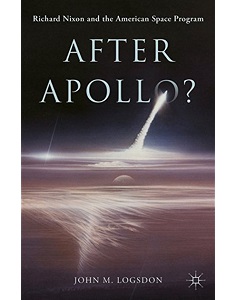Some books are long in gestation, but 44 years for this one must be some kind of record – even for a history book. However, there is no downside to the delay in this case. Firstly, the author is – as the jacket reminds us – “a world-recognised historian and analyst of space issues” (so no potted histories here!). And secondly, the delay has allowed the author time to consult the archives of various NASA Administrators and political figures such as Caspar Weinberger and, of course, Richard Nixon. With its voluminous reference notes and substantial index, we can be assured of a professional treatment and, thanks to the skills of the author, it’s also a fascinating read.
In 14 chapters, John Logsdon transports his readers from the end of the Apollo era to the ‘What Next?’ Space Shuttle era with some damning analysis on the way. “The space program was not high on Nixon’s policy agenda”, says the author with intentional understatement. He quotes the president’s suggestion that Apollo 17 might be “the last time” in the century that men would walk on the Moon; Nixon, he opines, “ensured that his forecast would come true”.
In the final analysis, Logsdon contrasts Nixon’s space agenda with Kennedy’s decision to go to the Moon. The Apollo programme “lasted only from 1961 to 1975”, he says; Nixon’s decision to build the post-Apollo programme round the shuttle “had a far more lasting impact”. Indeed, he concludes that Nixon’s decision to approve a “full capability shuttle” amounted to a “policy failure”. The options for shuttle design and the reasoning behind this conclusion are fully explored in the book.
“I am sure that many people will not agree with my assessment of the Nixon space heritage, especially with respect to the space shuttle”, says the author, but rightly makes no apology. After a career devoted to the programme, he regrets that his conclusions are “so downbeat” but hopes that “better days are ahead”. You may or may not agree with his analysis but it offers plenty of food for thought with reference to the direction of future US space policy.
Mark Williamson











